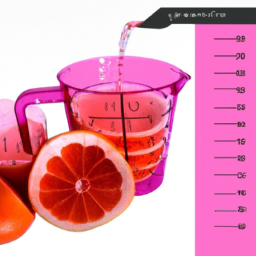I love adding lime juice to my food and beverages. But I’ve always wondered how much juice you can get from one lime. It can be frustrating when you cut into a lime and only get a tiny amount of juice.
That’s why I decided to do some research and learn more about the factors that impact the amount of juice in a lime, as well as tips for getting the most juice out of your limes.
First, it’s important to understand that there are several factors that can affect how much juice a lime contains. These include the variety of lime, its ripeness, and how it was stored.
Additionally, the way you cut and juice the lime can also impact how much juice you are able to extract. By understanding these factors and following some simple tips and techniques, you can maximize the amount of juice you get from each lime and add a bright and tangy flavor to your dishes and drinks.
Key Takeaways
- The amount of juice in a lime can be affected by factors such as variety, ripeness, storage, and cutting/juicing techniques.
- To maximize lime juice yield, use ripe and larger limes, roll the lime before juicing, microwave limes for a few seconds, use a citrus juicer, and slice limes into quarters.
- Substitutes for lime juice include lemon juice and vinegar.
- Lime juice is loaded with antioxidants and flavonoids, can improve skin complexion, and adds a burst of tangy flavor to dishes and beverages.
Factors that Impact the Amount of Juice in a Lime
It’s important to note that the ripeness and size of a lime can greatly affect how much juice it yields. These factors directly impact the amount of juice that can be extracted from the lime, making them crucial to consider when squeezing limes for cooking or cocktail making.
When it comes to lime juice extraction techniques, it’s important to keep in mind that the amount of juice extracted can vary based on the ripeness and size of the lime. A ripe lime will generally yield more juice than an unripe one, while a larger lime will naturally contain more juice than a smaller one. Additionally, the way the lime is squeezed can also impact the amount of juice that is extracted.
By keeping these factors in mind, you can better estimate the amount of juice you can expect to extract from a lime.
Moving on to the subsequent section about the average amount of juice in a lime, it’s important to note that while there are general estimates, the actual amount can vary greatly depending on the factors mentioned above.
Average Amount of Juice in a Lime
On average, a lime contains a decent amount of zesty liquid. The amount of juice in a lime can vary depending on factors such as the ripeness, size, and texture of the fruit. However, according to a study conducted by the University of California, Davis, the average amount of juice in a lime is approximately 2 tablespoons or 30 milliliters. This may not seem like a lot, but it is enough to add a burst of tangy flavor to dishes and beverages.
To give you an idea of the amount of juice in a lime, here is a table comparing it to other citrus fruits:
| Fruit | Amount of Juice |
|---|---|
| Lime | 2 tablespoons or 30 milliliters |
| Lemon | 3 tablespoons or 45 milliliters |
| Orange | 1/2 cup or 120 milliliters |
Knowing the amount of juice in a lime can come in handy when preparing recipes that call for it. However, if you find yourself in a pinch and don’t have any limes on hand, lime juice substitutes such as lemon juice or vinegar can be used as a replacement in some recipes. Additionally, lime juice is a popular ingredient in cocktails, adding a refreshing and citrusy kick to drinks.
When it comes to extracting the most juice out of your limes, there are several tips and tricks to keep in mind. Let’s explore them in the next section.
Tips for Getting the Most Juice Out of Your Limes
When I want to get the most juice out of my limes, I’ve got a few tricks up my sleeve. First, I always roll the lime back and forth on the counter before cutting it open. This helps to break down the cell walls inside the lime and release more juice.
Second, if the lime is particularly stubborn, I’ll pop it in the microwave for 10-15 seconds before juicing.
Finally, I always use a citrus juicer to ensure that I’m getting every last drop of juice out of the lime.
Roll the Lime Before Juicing
First things first, grab that lime and give it a good roll before juicing it, to really get those juices flowing! Rolling the lime helps to break down the fibers and membranes inside the fruit, allowing the juice to be released more easily. This technique is especially helpful when the lime is cold, as the rolling process helps to warm it up and make it more pliable.
In addition to the benefits of rolling, it’s also important to make sure that your lime is at room temperature before juicing. When a lime is too cold, the juice is more difficult to extract and may not be as flavorful. Allowing the lime to come to room temperature for about 30 minutes before juicing can make a big difference in the amount and quality of juice you’re able to get.
With these tips in mind, you’ll be ready to move on to the next step of juicing – microwaving the lime to further increase its juiciness.
Microwave the Lime Before Juicing
To really amplify your lime juice game, try popping the citrus in the microwave for a few seconds before squeezing – it’s like giving your lime a personal sauna session!
Microwaving limes for a few seconds can help break down the cell walls, making them easier to juice and allowing you to extract more juice from each lime. This is particularly helpful when you’re making cocktails or dishes that require a lot of lime juice.
The benefits of microwaving citrus don’t stop at juicing. Microwaved limes can also be used as a flavor enhancer by adding them to recipes such as salsa, guacamole, or marinades. The heat from the microwave releases the lime’s essential oils, intensifying the flavor of the fruit.
So, next time you’re in the kitchen, consider microwaving your limes for a quick and easy way to elevate your dishes. Now, let’s move on to the next step: using a citrus juicer.
Use a Citrus Juicer
Get ready to upgrade your lime squeezing game with the help of a citrus juicer – you’ll never want to go back to hand-squeezing again! While there are citrus juicer alternatives out there, such as electric and manual juicers, using a citrus juicer is the most efficient way to extract the maximum amount of juice from a lime.
Not only does it save time and effort, but it also ensures that you get the most out of your fruit. One of the benefits of hand squeezing is that it allows you to control the amount of pressure you apply, which can affect the quality of the juice. However, with a citrus juicer, you can adjust the pressure settings to ensure that you get the desired amount of juice without compromising its quality.
Additionally, citrus juicers come in different sizes and shapes, making them suitable for different types of citrus fruits. With a citrus juicer, you can easily extract juice from limes, lemons, oranges, and grapefruits without having to switch between tools.
Ready to take your lime squeezing game to the next level? Let’s explore some of the essential tools for juicing limes.
Tools for Juicing Limes
Using a handheld juicer, you can easily extract the juice from a lime in just a few squeezes. This tool is specifically designed for citrus fruits and allows you to effectively extract the maximum amount of juice without any pulp or seeds. It’s important to choose a juicer with a comfortable grip and sturdy construction to ensure that it can handle the tough outer skin of a lime.
Alternative methods, such as using a fork or reaming the lime with your hands, can be messy and inefficient. Common mistakes when using a handheld juicer include not applying enough pressure or not positioning the lime correctly. It’s important to firmly press the lime onto the juicer and rotate it while squeezing to get the most juice out.
To move onto the next step of juicing a lime, you’ll need to know how to cut it properly.
How to Cut a Lime for Juicing
Slicing into a lime with a sharp knife is like a surgeon delicately making an incision. As you carefully cut it into quarters, make sure to avoid any unwanted pulp or seeds. This process not only ensures that you get the most juice out of the lime, but also allows you to easily add a splash of lime juice to any dish.
Lime juice is a versatile ingredient that can be used in many different types of dishes, from salads and marinades to cocktails and desserts. When it comes to cutting limes for garnish, there are a few different methods to choose from. One popular technique is to slice the lime in half and then cut a small triangle out of the center, creating a notch that can be placed on the rim of a glass. Another option is to cut thin slices and then cut those slices in half, creating small wedges that can be used to garnish dishes.
Regardless of which method you choose, it’s important to remember that limes should be cut fresh and used immediately for the best flavor and texture. Moving on to the next section, let’s talk about how to store limes to maximize juice yield.
How to Store Limes to Maximize Juice Yield
To keep your limes fresh and flavorful for longer periods, it’s essential to store them in a cool and dry place, such as the refrigerator. Lime storage is crucial since they can easily spoil due to their high moisture content.
When stored at room temperature, limes can only last for up to a week. However, refrigerating them can extend their shelf life up to four weeks.
Different types of lime have varying juice yields, which can affect the amount of juice you get from each fruit. Persian limes, also known as Tahiti limes, are the most common type and produce the most juice. Key limes, on the other hand, have a higher acidity level and a stronger flavor, but their juice yield is lower.
To maximize the juice yield, it’s best to store your limes at room temperature for a few hours before juicing them. This will help soften the fruit, making it easier to extract the juice.
When it comes to cooking, lime juice is a versatile ingredient that adds a zesty tang to many dishes. From marinades to salad dressings, lime juice can elevate any recipe.
In the next section, we’ll explore some delicious recipes that use lime juice as a key ingredient.
Recipes That Use Lime Juice
When you’re craving a dish with a burst of citrus flavor, there are plenty of recipes that call for the tangy taste of this small green fruit. Lime juice is a staple ingredient in many cocktails, adding a refreshing and zesty kick to classic drinks like margaritas and mojitos.
It’s also a popular addition to marinades and dressings, bringing a bright acidity to savory dishes like grilled chicken or shrimp salads. Aside from its culinary uses, lime juice also offers a range of benefits for the skin. Its high vitamin C content can help to brighten and even out the complexion, while its natural acidity makes it a gentle exfoliant that can help to unclog pores and reduce the appearance of blemishes.
Whether you’re looking to add a tangy twist to your cocktails or give your skin a refreshing boost, lime juice is a versatile ingredient that can be used in a variety of ways. As much as we love lime juice, sometimes it’s just not available or practical to use in a recipe. Fortunately, there are several substitutes that can be used in its place, such as lemon juice, vinegar, or even orange juice.
These alternatives can be used in similar quantities and will provide a similar level of acidity and flavor to your dish. So don’t let a lack of lime juice hold you back – experiment with different substitutes and find the perfect flavor for your next culinary creation.
Substitutes for Lime Juice
I often find myself in the kitchen, ready to whip up a recipe that calls for lime juice, only to realize I’m all out. Luckily, there are some great substitutes that can save the day.
One option is lemon juice, which has a similar tangy flavor and acidity level.
Vinegar is another option, particularly if you’re making a savory dish.
Finally, citric acid can be used in small amounts to mimic the tartness of lime juice.
Lemon Juice
You’ll be amazed at how much flavor a little squeeze of lemon juice can add to your dish. While lime juice is often the go-to citrus for many recipes, lemon juice can be just as effective and even offer some unique benefits. Lemon juice has a higher acidity level than lime juice, which can help to balance out sweetness in desserts or add a tangy kick to savory dishes. Additionally, lemon juice has a higher vitamin C content than lime juice, making it a great way to boost your immune system while adding flavor to your meals.
To further emphasize the benefits of lemon juice, let’s take a look at a comparison between the two citrus fruits:
| Property | Lemon | Lime |
|---|---|---|
| Acidity Level | Higher | Lower |
| Vitamin C Content | Higher | Lower |
| Flavor Profile | Tangy, Bright | Tart, Sour |
As you can see, while lime juice may be more commonly used, lemon juice offers a unique flavor and nutritional profile that shouldn’t be overlooked. Now, let’s move onto the next topic of vinegar and how it can be used in place of citrus juices for certain dishes.
Vinegar
Using vinegar in your cooking can be a versatile and flavorful alternative to citrus juices. Not only does it add a tangy taste, but it also has numerous health benefits.
Vinegar contains acetic acid, which has been shown to lower blood sugar levels, improve digestion, and even aid in weight loss. Aside from its health benefits, vinegar also has alternative uses in cooking. It can be used as a marinade for meat, a dressing for salads, and even as a substitute for baking powder. Mixing vinegar with baking soda creates a chemical reaction that helps baked goods rise.
With its many uses and health benefits, vinegar is definitely a staple ingredient in any kitchen. Moving on to the subsequent section about citric acid, it’s important to note that while vinegar is a great alternative to citrus juices, it doesn’t contain citric acid.
Citric acid is commonly found in citrus fruits like lemons and limes, and is often used as a natural preservative and flavor enhancer in food products.
Citric Acid
When biting into a juicy lemon, the tangy taste that fills your mouth is due to the presence of citric acid. This organic acid is commonly found in citrus fruits such as lemons, limes, and oranges. Citric acid has a sour taste and is often used in food and beverage industries as a natural preservative and flavor enhancer.
Citric acid has a variety of uses in the food industry. It is commonly used to add a sour taste to soft drinks, candies, and baked goods. It is also used as a natural preservative in canned fruits and vegetables. In addition to its culinary uses, citric acid has many benefits. It can improve the absorption of minerals such as calcium and iron, and can also help prevent kidney stones. With its numerous applications and benefits, citric acid is an essential ingredient in many food products today. As we shift our focus to the health benefits of lime juice, it is important to note that citric acid plays a significant role in promoting good health.
Health Benefits of Lime Juice
Feeling thirsty? Squeeze some lime juice into your water for a burst of flavor and a boost of vitamin C.
But did you know that lime juice also has numerous health benefits? Lime juice is loaded with antioxidants, which can help protect your cells from damage caused by free radicals. It also contains flavonoids, which have anti-inflammatory properties that can help reduce inflammation in the body.
Aside from its juice, lime is also used in various ways. The zest of lime can add flavor to dishes, while the leaves can be used in cooking and even in making tea. Lime is also a popular ingredient in cocktails, adding a refreshing and tangy taste to drinks.
So next time you’re looking for a healthy drink, consider adding lime juice to your water or trying out a lime-infused cocktail. Your taste buds and your body will thank you.
Frequently Asked Questions
How many limes do I need to make a certain amount of juice?
To make a certain amount of lime juice, it depends on the lime juice ratio and juicing technique. I suggest using a citrus juicer and calculating about 1/4 cup of juice per lime.
What is the difference in juice yield between a ripe and unripe lime?
The juice yield of a ripe lime is higher than an unripe one due to its higher acidity levels. A ripe lime can provide up to 2 tablespoons of juice, while an unripe one may only yield 1 tablespoon.
Can I use bottled lime juice instead of fresh lime juice in recipes?
Personally, I find bottled lime juice convenient for quick recipes, but there are pros and cons. It lacks the fresh taste of lime and may contain preservatives. Taste comparison varies for each recipe, so it’s up to personal preference.
How long do limes typically last before they lose their juice?
On average, limes last about 2-3 weeks before they start to lose their juice. Lime juice preservation can be affected by factors such as temperature, humidity, and the amount of air exposure. Proper storage in airtight containers can extend their shelf life.
Are there any negative health effects of consuming too much lime juice?
As someone who enjoys lime juice, it’s important to be aware of potential risks. Consuming too much can lead to tooth decay and digestive issues. Recommended intake is one lime per day to avoid negative health effects.
Conclusion
Well, that’s all, folks! I hope this article has helped you understand more about how much juice is in a lime and how to get the most out of these little green wonders.
It’s amazing how such a small fruit can pack such a punch of flavor and nutrition. But before we go, let me ask you this: Have you ever tried a dish without lime juice and felt like it was missing something?
That’s because lime juice has a unique tangy and refreshing flavor that can elevate any dish to the next level. So next time you’re in the kitchen, don’t forget to grab a lime and add some zing to your meal.
Cheers to the power of limes!
Ilana has been a vegan for over 10 years. She originally made the switch for health reasons, but soon found herself becoming more and more passionate about the ethical and environmental implications of a vegan lifestyle. Ilana is the author of The Graceful Kitchen, a blog all about veganism. She loves to cook up delicious and nutritious vegan meals, and share her recipes with others who are interested in leading a cruelty-free life. Ilana is also a strong advocate for using whole foods as the foundation of a healthy diet, and believes that going vegan is one of the best ways to achieve this.









